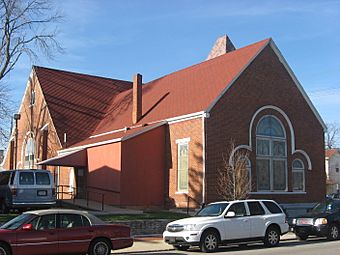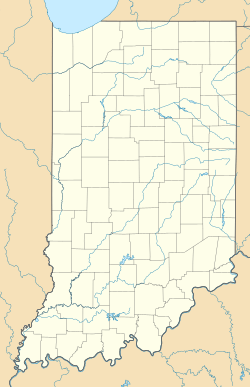Bethel A.M.E. Church (Richmond, Indiana) facts for kids
Quick facts for kids |
|
|
Bethel A.M.E. Church
|
|

Bethel AME Church, December 2012
|
|
| Location | 200 S. 6th St., Richmond, Indiana |
|---|---|
| Area | less than one acre |
| Built | 1854, 1892-1894 |
| Architectural style | Classical Revival, Romanesque |
| NRHP reference No. | 75000032 |
| Added to NRHP | September 5, 1975 |
Bethel A.M.E. Church is a very old and important church in Richmond, Indiana. It belongs to the African Methodist Episcopal (AME) faith. This church was first built in 1854. Later, between 1892 and 1894, it was made bigger and updated. It now shows a mix of Romanesque Revival and Neo-classical styles.
The church is a one-story brick building. It has a special shape like a cross and a tall bell tower. For many years, Bethel A.M.E. Church has been a key place for the local African American community. It serves as a center for learning, political discussions, and cultural events. The church was added to the National Register of Historic Places in 1975.
Contents
The Church's Early Years (1836-1868)
Richmond, Indiana, was first settled around 1806. It was an important place during the time of America's expansion westward. Many different groups of people came to live in Richmond. These included Quakers, people from New England, and African Americans. By the 1830s, over 400 Black residents lived in Wayne County, especially in and around Richmond.
Bethel African Methodist Episcopal (AME) Church shows how important and strong the Black community was in Richmond during the early 1800s. The church has continued to be a symbol of this community. It remains a center for political and cultural life today.
How Bethel Church Started
The Bethel Richmond Church was started in 1836. It was founded by Bishop William Paul Quinn, who traveled a lot for the church. The church has served the community for almost 200 years. Early leaders included Cornelius Overman and George Black. Bishop Quinn officially opened the church in 1837 after getting land from Gardner Mendenhall.
Quinn became the AME Church's fourth Bishop in 1844. From 1840 to 1845, about 119 members were part of the Bethel Congregation. Richmond became a main spot for the AME church to help people who had escaped slavery during the 1840s and 1850s. The church building still has its simple Methodist design from 1854 inside.
The Market-Marion Church (1868-Present)
In 1868, the Bethel Congregation bought an existing church building. This building was at the corner of Market and Marion streets. It was built in the Greek Revival style. Bethel Richmond Church still uses this 19th-century building today.
Important Leaders and Changes
James M. Townsend was a pastor at Bethel Richmond. He was also a veteran who fought in the 54th Massachusetts Volunteers. Townsend served as an assistant secretary for the AME Church's national meetings. By 1885, he was a well-known person in Richmond. He also became the second African American to be elected to the state legislature in Indiana.
While in the legislature, Townsend tried to remove all laws that separated people by race. He successfully passed a bill that stopped discrimination in public places. However, he could not change all of Indiana's laws. He returned to Richmond in 1891 and was the pastor of Bethel Richmond for two years. Later, he moved to lead the AME church in Indianapolis and then in Chicago.
Fighting for Justice
In 1921, Bethel Richmond created a statement against the increase of violence against Black people across the country. They asked Indiana's congressmen and senators to create federal laws to stop such violence. Later, a newspaper called Indianapolis Times showed that many Indiana government officials were involved with the Ku Klux Klan.
The church building has stayed mostly the same on the outside and inside. The only major change was an addition in 1892. Bethel Richmond has been on the National Register of Historic Places since 1975. The church in Richmond is one of the oldest AME churches in Indiana.


